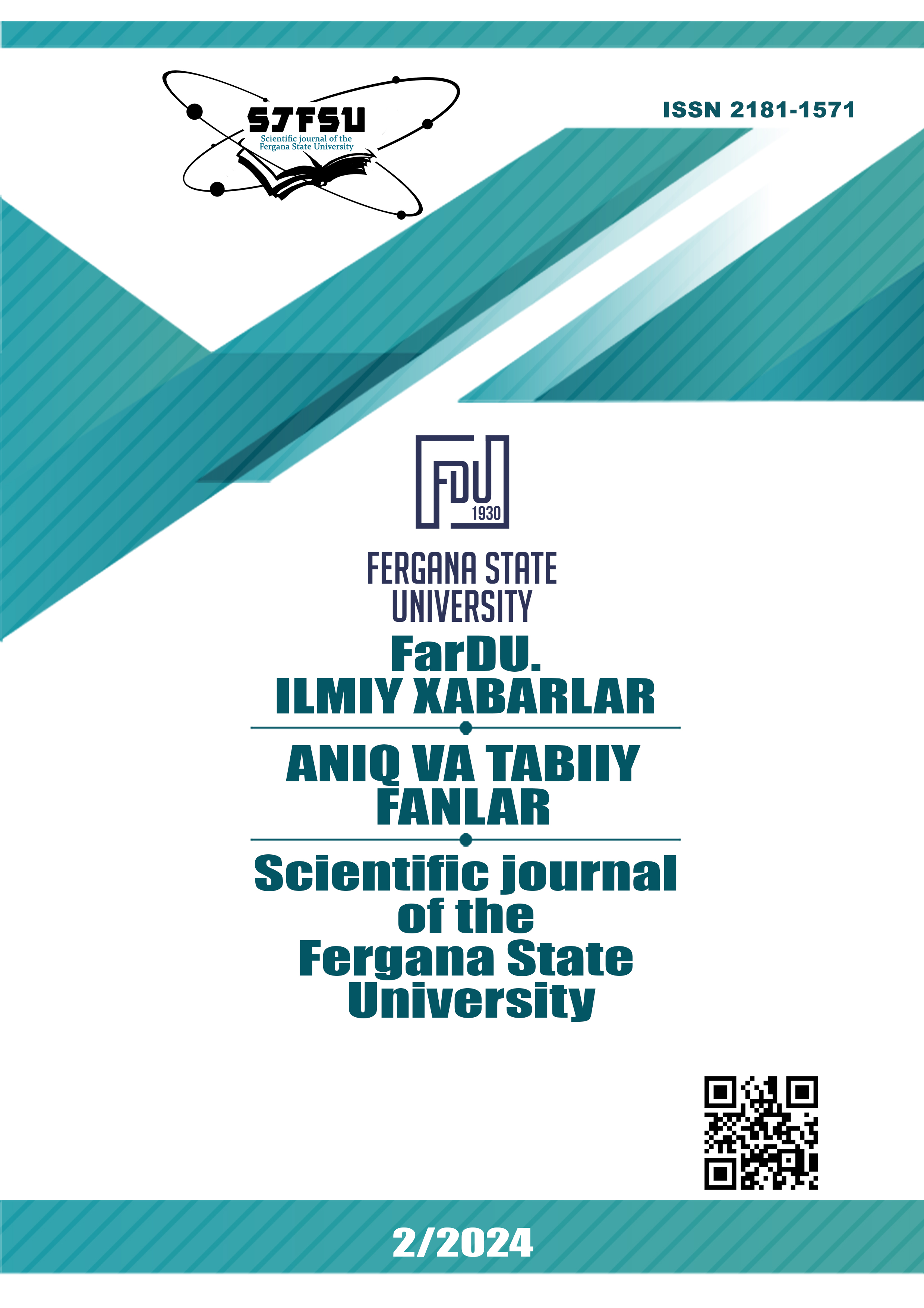STUDYING THE COMPOSITION OF THE ESSENTIAL OIL OF THE AERIAL PART OF SALVIA DESERTA FLORA OF UZBEKISTAN
Main Article Content
Abstract
The component composition of the essential oil obtained by hydrodistillation from the aerial part of the plant Salvia deserta (desert sage), growing in the vicinity of the village of Chodak in the Namangan region, was studied. In the composition of the essential oil, 86 components were identified by GC-MS, which is 92.7% of the total mass of the oil. It has been established that the composition of the essential oil is dominated by sesquiterpene hydrocarbons (32.2%) and oxidized monoterpenes (17.9%). The major components of the essential oil are β-caryophyllene (12.8%), germacrene D (9.9%), spathulenol (8.5%), caryophyllene oxide (6.8%), camphor (5.7%), terpinen-4-ol (5.7%), dihydroselarene (3.3%), 1,8-cineole (3.1%).
Article Details

This work is licensed under a Creative Commons Attribution-NonCommercial-NoDerivatives 4.0 International License.
References
Растительные ресурсы СССР. Цветковые растения, их химический состав, использование. Семейства Hippuridaceae-Lobeliacae. Санкт-Петербург: Наука. 1991. C. 72-90.
Yi-Bing Wu, Zhi-Yu Ni, Qing-Wen Shi, Mei Dong, Hiromasa Kiyota, Yu-Cheng Gu, Bin Cong. Constituents from Salvia Species and Their Biological Activities. Chem Rev. 2012. Vol. 112 (11). Pp. 5967-6026.
Jie Wang, Jianping Xu, Xue Gong, Min Yang, Chunhong Zhang, Minhui Li. Biosynthesis, Chemistry, and Pharmacology of Polyphenols from Chinese Salvia Species: A Review. Molecules. 2019. Vol. 24: 155.
О.А. Турдибоев, O.T. Тургинов. Таксономический состав рода Salvia L. во флоре Узбекистана. Узбекский биологический журнал. 2021., №1. C. 34-38.
Núria Llurba-Montesino, Thomas J. Schmidt. Salvia Species as Sources of Natural Products with Antiprotozoal Activity. Int. J. Mol. Sci. 2018. Vol. 19 (1): 264.
Abdukriem Kadir, Guijuan Zheng, Xiaofeng Zheng, Pengfei Jin, Maitinuer Maiwulanjiang, Biao Gao, Haji Akber Aisa, Guangmin Yao. Structurally Diverse Diterpenoids from the Roots of Salvia deserta Based on Nine Different Skeletal Types. J. Nat. Prod. 2021. Vol. 84. Pp. 1442−1452.
Zhussupova A., Zhumaliyeva G., Ogay V., Issabekova A., Ross S. A., Zhusupova G. E. Immunomodulatory Effects of Plant Extracts from Salvia deserta Schang. and Salvia sclarea L. Plants (Basel). 2022. Vol. 11(20): 2690.
Wang Y.-R., Yu Y., Li S.-M., Liu W., Li W., Morris-Natschke S. L., Huang, X.-F. Salvisertin A, a New Hexacyclic Triterpenoid, and Other Bioactive Terpenes from Salvia deserta Root. Chemistry and Biodiversity. 2018. Vol. 15(4), e1800019.
Bo Li, Chenlu Zhang, Liang Peng, Zongsuo Liang, Xijun Yan,Yonghong Zhu , Yan Liu. Comparison of essential oil composition and phenolic acid content of selected Salvia species measured by GC–MS and HPLC methods. Industrial Crops and Products. 2015. Vol. 69. Pp. 329–334.
Bufalo J., Cantrell C.L., Jacob M.R., Schrader K.K., Tekwani B.L., Kustova T.S., Ali A., Boaro C.S.F. Antimicrobial and antileishmanial activities of diterpenoids isolated from the roots of Salvia deserta. Planta Med. 2016. Vol. 82. Pp. 131–137.
Zheng X., Kadir A., Zheng G., Jin P., Qin D.,Maiwulanjiang M., Aisa H. A., Yao G. Antiproliferative abietane quinone diterpenoids from the roots of Salvia deserta. Bioorganic Chemistry. 2020. Vol. 104: 104261.
Kasimu R., Wang X., Wang X., Hu J., Wang X., Mu Y. Antithrombotic effects and related mechanisms of Salvia deserta Schang root EtOAc extracts. Sci. Rep. 2018. Vol. 8:17753.
Wang X.L., Wang X.Q., Wang X.M., Hu J.P., Rena K. Study on the chemical constituents of EtOAc extraction from Salvia deserta. West China J Pharm Sci. 2014. Vol. 29. Pp.257–259.
Wang X., Yu Y., Wang X., Hu J., Wang X., Li M., Rena K. Simultaneous determination of 5 salvianolic acid constituents in the roots and rhizomes of Salvia deserta Schang by HPLC. Yaowu Fenxi Zazhi. 2016. Vol.36. Pp. 805–810.
Zheng G., Kadir A., Zheng X., Jin P., Liu J., Maiwulanjiang M., Yao G., Aisa H.A. Spirodesertols A and B, two highly modiƫed spirocyclic diterpenoids with an un-precedented 6-isopropyl-3H-spiro[benzofuran-2,1ʹ-cyclohexane] motif from Salvia deserta. Org. Chem. Front. 2020. Vol. 7. Pp. 3137-3145.
Королюк Е.А., Кёниг В., Ткачева А.В. Состав эфирного масла двух видов рода шалфей (Salvia deserta Schang и Salvia verticillata L.) из Алтайского края. Химия растительного сырья.2002. № 1. С. 43–48.
Adams R.P. Identification of Essential Oil Components by Gas Chromatography/Mass Spectrometry, ed. 4.1. Allured Publishing Corporation, Carol Stream, Illinois, 2017. 804p.
Babushok V.I., Linstrom P.J., Zenkevich I.G.J. Retention Indices for Frequently Reported Compounds of Plant Essential Oils. Phus. Chem. Ref.Data. 2011. Vol. 40. №4. 043101.
Babushok V.I., Andriamaharavo N.R. Use of large retention index database for filtering of GC–MS false positive identifications of compounds. Chromatographia. 2012. Vol. 75, Pp. 685–692.
Sharma C., Al Kaabi J.M., Nurulain S.M., Goyal S.N., Kamal M.A., Ojha S. Polypharmacological Properties and Therapeutic Potential of β-Caryophyllene: A Dietary Phytocannabinoid of Pharmaceutical Promise. Curr Pharm Des. 2016. Vol. 22(21). Pp.3237-64.

